
Brønnøy is a municipality in Nordland county, Norway. It is part of the Helgeland region. The administrative centre and commercial centre of the municipality is the town of Brønnøysund. A secondary centre is the village of Hommelstø. Other villages include Tosbotnet, Lande, Trælnes, and Skomo.

Herøy is a municipality in Nordland county, Norway. It is part of the Helgeland traditional region. The administrative centre of the municipality is the village of Silvalen. The island municipality is located about 15 kilometres (9.3 mi) west of the town of Sandnessjøen.

Lurøy is a municipality in Nordland county, Norway. It is part of the Helgeland traditional region. The administrative centre of the municipality is located on the island of Onøya. Other villages in Lurøy include Aldra, Haugland, Konsvikosen, Lovund, Lurøy, Sleneset / Solværøyene, Stokkvågen, and Tonnes.

Mosjøen or Mussere (Southern Sami) is a town in Vefsn Municipality in Nordland county, Norway. Mosjøen is the oldest town in the Helgeland region, with only the town of Bodø being older within Nordland county. The town is also the administrative centre of Vefsn Municipality. The old village of Mosjøen was declared a ladested in 1875. It was also a town-municipality from 1875 until 1961 when it was merged into Vefsn Municipality, losing its status as a town (ladested). It is also a former garrison town and customs place. After a change in law during the 1990s, the urban area of Mosjøen was declared to be a town once again in 1998. People from Mosjøen are referred to using the demonym "mosjøværing". The 6.55-square-kilometre (1,620-acre) town has a population (2024) of 10,059 and a population density of 1,536 inhabitants per square kilometre (3,980/sq mi).

Brønnøysund is a town and the administrative centre of Brønnøy Municipality in Nordland county, Norway. The 3.38-square-kilometre (840-acre) town has a population (2024) of 5,093 and a population density of 1,507 inhabitants per square kilometre (3,900/sq mi).
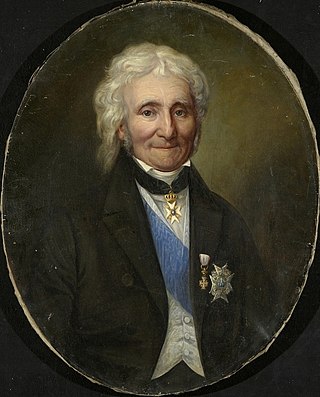
Jonas Collett was a Danish-Norwegian public official, legislator, and statesman. Born on the Rønnebæksholm estate at Næstved in Denmark, he remained in Norway after the termination of the personal union with Denmark in 1814. He was the First minister of Norway (1822-1836).
Peter Fredrik Feilberg was a Norwegian newspaper editor, bookseller and printer, who also served as mayor of Skien.
Jonas Schanche Kielland was a Norwegian consul and politician, particularly associated with Stavanger.
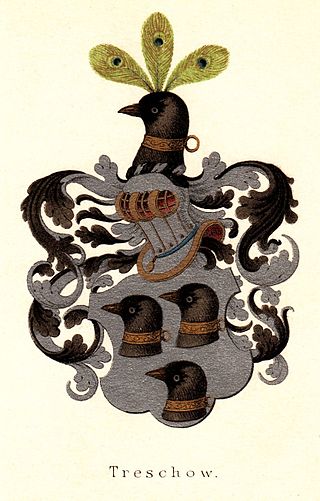
The Treschow family is a noble family originating in Denmark and with branches in Norway and Sweden. The family name means "wooden shoe-maker" and the family later counted many merchants in the 17th century and priests in the 18th century. A member of the family, Michael Treschow, bought the status of untitled (lower) nobility in Denmark in 1812, although Norway, where he was resident, abolished the concept of nobility only a few years later. Members of this family have been industrialists and landowners, notably in Vestfold.
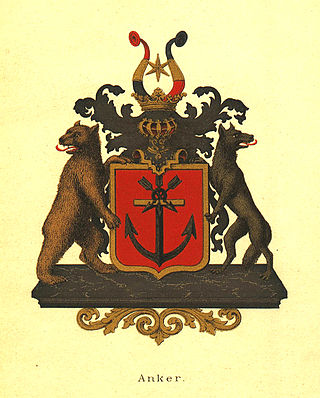
The Anker family, also spelled Ancher, is a Danish and Norwegian noble family living in Norway. The name means anchor. Originally from Sweden, the family became a part of the Patriciate of Norway in the 18th century, and members of the family were ennobled in 1778. One line of the family living in Mecklenburg became part of the German nobility, but later went extinct.

The Husby Estate is an estate in Helgeland, Norway. It is based in the village of Husby on the southwestern part of the island of Tomma in what is now Nesna Municipality.
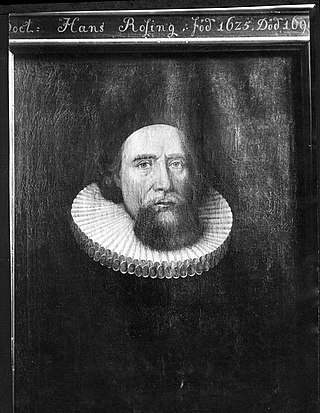
Hans Rosing was a Norwegian clergyman. He served as Bishop of the Diocese of Oslo from 1664 until 1699.
Niels Hanssøn Meng was a Norwegian timber trader, property owner and civil leader.

Jens Bang was a wealthy Danish merchant.
Jørgen Olufsen was a Danish politician. Olufsen built Jørgen Olufsen's House, Denmark's best preserved merchant's mansion in the Renaissance style. The son of the Horsens merchant, Hans Felthuus, and his wife, Sidsel Jørgensdatter, he was named after his grandfather, Jørgen Olufsen, who was mayor of Horsens. He moved to Aalborg where he married Maren Pops, the daughter of Mayor Povl Pops. Olufsen younger half-brother, the merchant Jens Bang, built his own mansion, Jens Bang's House.

Anders Jensen Horgen was a Norwegian farmer and politician for the Labour, Social Democratic Labour and Communist parties.
Hans Eggertsen Stockfleth was a Norwegian civil servant, businessman and investor.
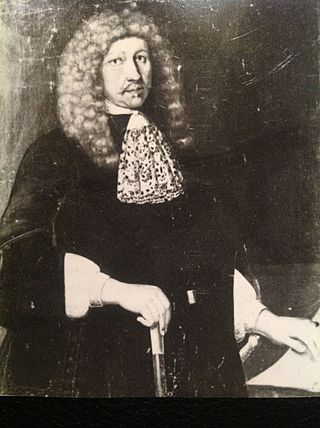
Preben von Ahnen was a Norwegian civil servant and landowner.

Hans Rostgaard was a Danish bailiff (ridefoged) and county administrator (amtsforvalter) at Helsingør who is remembered for his achievement in the Second Northern War and especially his role during the Swedish siege of Copenhagen and subsequent assault on the city in 1659. He is also associated with Krogerup Manor in Humlebæk where a statue of him by Hans Peder Pedersen-Dan was installed in 1904. He was the father of Frederik Rostgaard and the uncle of Jens Rostgaard.

Orebygaard is a manor house and estate located on Lolland in southeastern Denmark. The current main building, a Neo-Renaissance style building with two towers, is from 1872 to 1874. It was listed on the Danish registry of protected buildings and places in 1985.


















